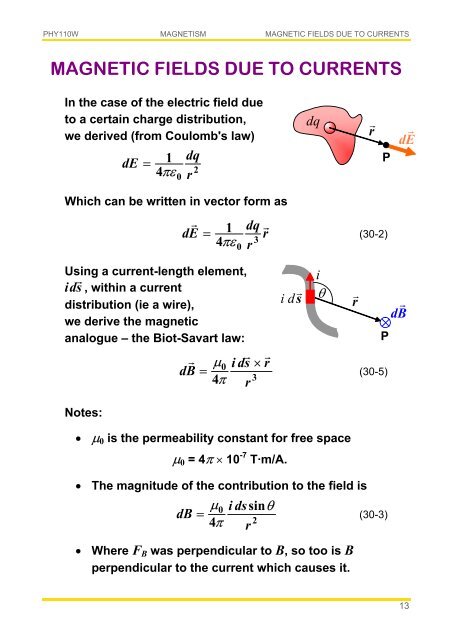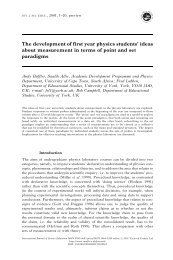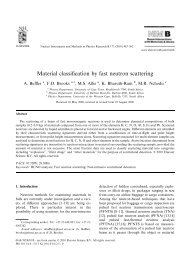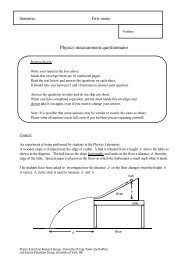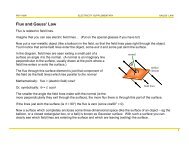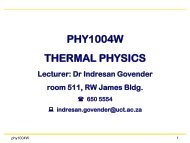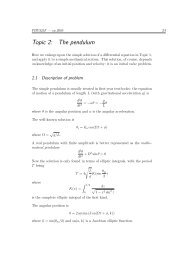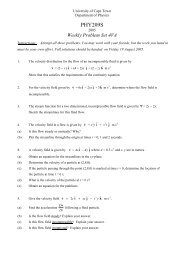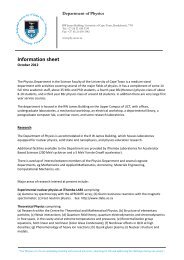You also want an ePaper? Increase the reach of your titles
YUMPU automatically turns print PDFs into web optimized ePapers that Google loves.
PHY110W MAGNETISM <strong>MAGNETIC</strong> <strong>FIELDS</strong> <strong>DUE</strong> <strong>TO</strong> <strong>CURRENTS</strong><br />
<strong>MAGNETIC</strong> <strong>FIELDS</strong> <strong>DUE</strong> <strong>TO</strong> <strong>CURRENTS</strong><br />
In the case of the electric field due<br />
to a certain charge distribution,<br />
we derived (from Coulomb's law)<br />
dE<br />
=<br />
1<br />
4πε<br />
0<br />
dq<br />
2<br />
r<br />
dq<br />
r <br />
P<br />
dE <br />
Which can be written in vector form as<br />
<br />
dE =<br />
1<br />
4πε<br />
0<br />
dq <br />
r<br />
3<br />
r<br />
(30-2)<br />
Using a current-length element,<br />
ids , within a current<br />
distribution (ie a wire),<br />
we derive the magnetic<br />
analogue – the Biot-Savart law:<br />
<br />
µ 0 ids<br />
dB =<br />
4π<br />
r<br />
Notes:<br />
×<br />
3<br />
<br />
r<br />
i<br />
i ds θ<br />
r dB <br />
×<br />
P<br />
(30-5)<br />
• µ 0 is the permeability constant for free space<br />
µ 0 = 4π × 10 -7 T·m/A.<br />
• The magnitude of the contribution to the field is<br />
µ 0 idssinθ<br />
dB<br />
4π<br />
2<br />
r<br />
= (30-3)<br />
• Where F B was perpendicular to B, so too is B<br />
perpendicular to the current which causes it.<br />
13
PHY110W MAGNETISM <strong>MAGNETIC</strong> <strong>FIELDS</strong> <strong>DUE</strong> <strong>TO</strong> <strong>CURRENTS</strong><br />
<strong>MAGNETIC</strong> FIELD <strong>DUE</strong> <strong>TO</strong> CURRENT<br />
IN A LONG, STRAIGHT WIRE<br />
d s <br />
i<br />
s<br />
θ<br />
R<br />
r<br />
× dB<br />
P<br />
Using symmetry (every current element ds in the upper<br />
half of the wire has a corresponding element in the<br />
lower half causing the same field at P), the magnitude<br />
of the magnetic field at point P due to a long, straight,<br />
current-carrying wire is<br />
∞<br />
0i<br />
2 4<br />
µ<br />
B = sinθ<br />
ds<br />
π ∫ (30-7)<br />
2<br />
r<br />
0<br />
= ° − =<br />
R<br />
, and<br />
r<br />
where sinθ<br />
sin( 180 θ)<br />
∴ B =<br />
µ 0i<br />
2π<br />
∞<br />
∫<br />
0<br />
R<br />
(<br />
2 2)<br />
s<br />
+<br />
R<br />
32<br />
ds<br />
2 2<br />
r = s + R<br />
∞<br />
µ 0i<br />
⎡ s ⎤<br />
∴ B = 12<br />
2π<br />
R ⎢( 2 2<br />
s R ) ⎥<br />
⎣ + ⎦0<br />
µ 0i<br />
∴ B = (30-6)<br />
2π<br />
R<br />
The direction of B is given by the RH curled fingers rule.<br />
14
PHY110W MAGNETISM <strong>MAGNETIC</strong> <strong>FIELDS</strong> <strong>DUE</strong> <strong>TO</strong> <strong>CURRENTS</strong><br />
THE <strong>MAGNETIC</strong> FIELD AROUND A LONG,<br />
STRAIGHT, CURRENT-CARRYING WIRE<br />
i<br />
B<br />
r<br />
The force a current-carrying wire experiences in an<br />
external magnetic field is therefore due to the<br />
superpositioning of the two magnetic fields:<br />
N<br />
S<br />
…<br />
N<br />
F <br />
S<br />
15
PHY110W MAGNETISM <strong>MAGNETIC</strong> <strong>FIELDS</strong> <strong>DUE</strong> <strong>TO</strong> <strong>CURRENTS</strong><br />
<strong>MAGNETIC</strong> FIELD <strong>DUE</strong> <strong>TO</strong> CURRENT<br />
IN A CIRCULAR WIRE<br />
i<br />
R<br />
α<br />
x<br />
r <br />
dB y<br />
P<br />
α<br />
dB <br />
dB x<br />
From the Biot-Savart law, the field at point P (along the<br />
axis of the a circular loop, radius R), due to a differential<br />
current element ids at the top of the loop, is given by<br />
<br />
<br />
µ 0 idssinα<br />
µ 0i<br />
ds<br />
dB = =<br />
2<br />
( 2 2<br />
4π<br />
r 4π<br />
R + x )<br />
By symmetry, all the components perpendicular to the<br />
axis (dB y ) sum to zero, so we need consider only dB x :<br />
dB<br />
x<br />
µ 0i<br />
ds µ 0i<br />
ds R<br />
= cosα<br />
=<br />
4π<br />
R + x 4 R + x R + x<br />
( 2 2) π ( 2 2) ( 2 2)<br />
12<br />
i, R and x have the same values for all elements around<br />
the loop, so when we integrate around the circumference…<br />
B<br />
x<br />
µ 0iR<br />
=<br />
4π<br />
R + x<br />
(<br />
2 2)<br />
32<br />
∫ ds (and ∫ ds is just 2πR)<br />
so<br />
B<br />
x<br />
=<br />
2<br />
µ iR<br />
0<br />
2<br />
(<br />
2 2)<br />
R<br />
+<br />
x<br />
32<br />
(30-28)<br />
16
PHY110W MAGNETISM <strong>MAGNETIC</strong> <strong>FIELDS</strong> <strong>DUE</strong> <strong>TO</strong> <strong>CURRENTS</strong><br />
A CURRENT-CARRYING COIL<br />
AS A <strong>MAGNETIC</strong> DIPOLE<br />
By considering a cross-section<br />
through a current-carrying coil, we<br />
can see why such an arrangement<br />
can be viewed as a magnetic dipole.<br />
i<br />
i out<br />
i in<br />
For a coil of N turns the magnetic<br />
dipole moment was determined to be µ = NiA (29-33)<br />
So the magnetic field along the axis of a currentcarrying<br />
coil can be written as<br />
B x<br />
µ 0µ<br />
=<br />
2π<br />
R + x<br />
(<br />
2 2)<br />
and for large distances x >> R,<br />
µ µ<br />
B x<br />
2π<br />
x<br />
32<br />
0<br />
= (30-29)<br />
3<br />
… which has the identical form to the expression for<br />
the electric field along the axis of an electric dipole:<br />
E<br />
p<br />
= (23-9)<br />
3<br />
2πε0z<br />
A current loop produces a magnetic<br />
field like that of a bar magnet and<br />
thus has north and south poles.<br />
The direction of µ is given by the<br />
right hand curled fingers rule.<br />
S<br />
µ N<br />
17
PHY110W MAGNETISM <strong>MAGNETIC</strong> <strong>FIELDS</strong> <strong>DUE</strong> <strong>TO</strong> <strong>CURRENTS</strong><br />
<strong>MAGNETIC</strong> FIELD <strong>DUE</strong> <strong>TO</strong><br />
A MOVING CHARGE<br />
From the Biot-Savart law, the field due to a differential<br />
current element ids is given by<br />
<br />
µ 0 ids×<br />
r<br />
dB =<br />
4π<br />
3<br />
r<br />
<br />
Setting ds =<br />
<br />
dQ<br />
v dt , and i = , we get<br />
dt<br />
<br />
µ 0 dQ v × r<br />
dB =<br />
4π<br />
3<br />
r<br />
If we define the differential charge element dQ as the<br />
charge on a single particle contributing to the current,<br />
then the magnetic field due to a moving charged<br />
particle is given by<br />
<br />
µ 0 qv × r<br />
B =<br />
4π<br />
3<br />
r<br />
As before, the direction of B is given by the direction<br />
<br />
of the cross product v × r , or the right hand curled<br />
fingers rule.<br />
18
PHY110W MAGNETISM <strong>MAGNETIC</strong> <strong>FIELDS</strong> <strong>DUE</strong> <strong>TO</strong> <strong>CURRENTS</strong><br />
FORCE BETWEEN<br />
TWO PARALLEL CONDUC<strong>TO</strong>RS<br />
d<br />
B L<br />
F a<br />
b<br />
ba<br />
F <br />
ab<br />
B <br />
a<br />
i a<br />
i b<br />
b<br />
The magnitude of the magnetic field due to the current<br />
in wire a at every point on wire b is given by<br />
B<br />
a<br />
µ 0ia<br />
=<br />
2π<br />
d<br />
and consequently the magnitude of the force on wire b<br />
due to the magnetic field of wire a (written F ba ) is<br />
µ 0Liaib<br />
Fba = iLB b a = = Fab<br />
(30-15)<br />
2π<br />
d<br />
• F ba and F ab are an action-reaction pair.<br />
• Parallel currents attract.<br />
• Antiparallel currents repel.<br />
The ampere can now be defined as …<br />
that unvarying current which, when maintained in each<br />
of two parallel conductors of infinite length and situated<br />
one metre apart in empty space, causes between them a<br />
force of exactly 2 × 10 -7 N per metre of length.<br />
19
PHY110W MAGNETISM <strong>MAGNETIC</strong> <strong>FIELDS</strong> <strong>DUE</strong> <strong>TO</strong> <strong>CURRENTS</strong><br />
AMPERE’S LAW<br />
Gauss’s law related the surface integral of the electric<br />
flux over a closed (Gaussian) surface to the net amount<br />
of charge enclosed by that surface.<br />
Ampere’s law relates the line integral of the magnetic<br />
field around a closed (Amperian) loop to the net<br />
amount of current enclosed by that loop.<br />
Mathematically: ∫ B <br />
⋅ ds = µ 0iencl<br />
(30-16)<br />
Amperian<br />
loop<br />
i 3<br />
i 1<br />
i 2<br />
ds <br />
θ<br />
B <br />
According to the right hand curled fingers rule, as we<br />
integrate anticlockwise around the above loop i 1 is<br />
regarded as positive, while i 2 is negative.<br />
i 3 is ignored because it is not enclosed by the loop.<br />
<br />
B⋅ ds = Bdscosθ = µ i − i<br />
∫<br />
∫<br />
0 1 2 (30-18)<br />
So: ( )<br />
In the same way Gauss’s law helped to determine the<br />
magnitude of electric fields due to symmetrical charge<br />
distributions, Ampere’s law is useful in determining the<br />
magnitude of the resultant magnetic fields due to<br />
current distributions which have some symmetry…<br />
20
PHY110W MAGNETISM <strong>MAGNETIC</strong> <strong>FIELDS</strong> <strong>DUE</strong> <strong>TO</strong> <strong>CURRENTS</strong><br />
APPLICATIONS OF AMPERE’S LAW I<br />
Magnetic field outside a long, straight conductor<br />
For a long, straight wire<br />
carrying current directly<br />
out of the page the<br />
symmetry dictates that we<br />
surround the wire with a<br />
concentric circular<br />
Amperian loop of radius r.<br />
Amperian<br />
loop<br />
i<br />
ds B <br />
r<br />
B lies at a tangent to the loop everywhere on the loop,<br />
so the angle θ between B and ds is zero.<br />
<br />
∴ B⋅ ds = B ds = B2π<br />
r<br />
∫<br />
∫<br />
And applying Ampere’s law:<br />
B2π r = µ ( ) 0 + i<br />
So the magnitude of the magnetic field around a long,<br />
straight, current-carrying conductor is<br />
B<br />
µ i<br />
2π<br />
r<br />
0<br />
= (30-19)<br />
(Which agrees exactly with what was derived from the<br />
Biot-Savart law.)<br />
21
PHY110W MAGNETISM <strong>MAGNETIC</strong> <strong>FIELDS</strong> <strong>DUE</strong> <strong>TO</strong> <strong>CURRENTS</strong><br />
APPLICATIONS OF AMPERE’S LAW II<br />
Magnetic field of a solenoid<br />
A solenoid is a long, straight, closely<br />
wound helical coil of wire, usually<br />
with a constant diameter which is<br />
much smaller than its length.<br />
For an ideal solenoid<br />
(of infinite length, and no<br />
leakage) the magnetic<br />
field outside the solenoid<br />
is zero, while the field<br />
lines inside are straight<br />
and uniformly spaced.<br />
D<br />
A<br />
h<br />
C<br />
B<br />
B <br />
Using the rectangular Amperian loop ABCDA,<br />
B C D A <br />
B ⋅ ds = B ⋅ ds + B ⋅ ds + B ⋅ ds + B ⋅ ds = Bh<br />
∫ ∫ ∫ ∫ ∫<br />
A B C D<br />
Applying Ampere’s law to a solenoid with n turns per<br />
metre and carrying current i we get:<br />
Bh<br />
= µ i ( nh)<br />
So the magnitude of the magnetic field inside an<br />
infinitely long solenoid is<br />
0<br />
B<br />
= µ 0ni<br />
(30-25)<br />
The equation will work for real solenoids provided it is<br />
applied to interior points well away from the ends.<br />
22


